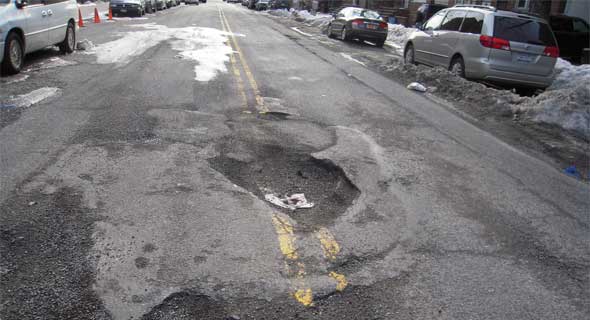How To Reduce The Number Of Potholes

THE COMMUTE: The NYC Department of Transportation (DOT) will insist the reason we have so many potholes is due to the weather. Of course, constant freezing and thawing of the roadway is the major cause of potholes. But there are other contributing factors that DOT does not want you to know about because, unlike the weather, they
arein the city’s control.
Winter is slightly only more than a third over, yet potholes have already sprouted all over due to the unusually harsh winter. Usually we do not see a massive amount of potholes until March. DOT claims to have already filled more than 50,000 potholes this January alone.
Budget cuts have necessitated furloughs, which the union opted for instead of layoffs, so there are fewer road crews making temporary cold patch repairs. These sometimes hold for only a few weeks and then have to be refilled again. Not very efficient, but DOT does not have much of a choice. It is their only option to keep their heads above water to keep the entire street and highway system from becoming hazardous. More permanent patch repairs and resurfacing are confined to Spring and Summer. According to CBS, the average response time for filling potholes increased from two days in 2007 to six days today due to budget cuts.
The situation is so serious that one morning, six cars were recently disabled along the Henry Hudson Parkway by the same group of potholes. Closer to home, sections of the Belt Parkway, eastbound, around Ocean Avenue and near the Mill Basin Bridge, were especially bad where it was necessary to slow down to 30 mph to avoid a jolting ride and possible damage to your car although the speed limit remained at 50 mph along these sections. The advice to motorists is to slow down. Most of those potholes have now been filled, at least until the next storm.
There was an especially bad pothole right in the center of Brighton 11th Street this week which did not pose much of a problem during the day if you were driving slowly and carefully. At night, however, it was treacherous, possibly causing serious damage or injury. It is unknown how long it was there, but as of three days ago it was repaired. Other conditions on the same block were not addressed which means rather than cruising the streets for potholes, DOT is just running from one reported pothole to the next, ignoring unreported minor ones until they become major ones.
What to do if your vehicle is damaged by a pothole
You can sue the City but according to NYC’s pothole law the City must first have 45 days notice to allow them time to fix it, so reporting potholes is important. To file a claim with the city, you must file a claim with the Office of the Comptroller which now can be done online.
In 2001, I successfully sued the city by taking them to small claims court and received reimbursement for a $90 repair bill. In my case the city first tried to shift blame to the gas company, claiming an inferior repaving of a utility repair caused the pothole. The gas company also denied any wrongdoing, and in the end they split the difference, each paying half. It may not be easy, but it certainly is possible to collect from the city.
Types of road repairs
Road reconstruction is the most comprehensive repair. This is usually done together with the installation of new sewers and sidewalks and could last up to 20 years or more. A more common repair is when just the road is milled and resurfaced. This may last for only five years for a heavily traveled street when the surface is asphalt and the base is concrete. (A concrete surface instead of asphalt is much more expensive and is rarely done on local streets. An example is Brighton Beach Avenue. That type of resurfacing can last as long as a total reconstruction.)
In this city, however, you never see local streets resurfaced every five years. You do see highways resurfaced as often as every three years because of greater wear and tear and faster vehicular speeds. In general, our streets are not resurfaced or reconstructed until they are severely deteriorated, but that is not always the case.
Last year Shore Boulevard in Manhattan Beach, which was in pretty decent shape, was resurfaced. This immediately led to increased speeding. Other streets had a greater need. Most of the Belt Parkway was resurfaced about three years ago. A few sections were neglected, for example near the Mill Basin Bridge, while other sections in Queens that were not in great need of repair were resurfaced. The areas that were not resurfaced are those with the greatest number of potholes this year.
So how can the number of potholes be minimized?
- By reconstructing and resurfacing streets on a timely schedule without stretching out that schedule as long as possible. Roads should be in decent shape before the winter begins.
- Ensuring that utilities make proper repairs when filling holes by having adequate inspections.
- Having the proper number of employees so that repairs are done more efficiently rather than just responding to emergencies.
- Allowing need to determine which roads get resurfaced or reconstructed, not political factors.
Weather is just one factor that causes potholes, and is by no means the only factor.
The Commute is a weekly feature highlighting news and information about the city’s mass transit system and transportation infrastructure. It is written by Allan Rosen, a Manhattan Beach resident and former Director of MTA/NYC Transit Bus Planning (1981).




